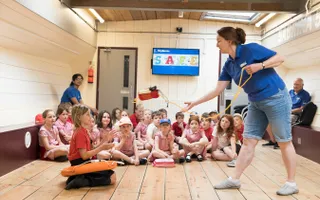Learn the Water Safety Code
- Stop & Think
- Stay Together
- Call 999
- Float
Stop & Think about the hidden dangers
- Low water temperatures cause the body to go into cold water shock and can claim a life in minutes.
- Water can be much deeper or shallower than expected and cause serious harm if jumping in.
- Steep slimy banks make it hard to get out of the water.
- The ground shelves away steeply so you can quickly become out of your depth. Look for signs and information boards to help you understand any dangers.
- Reeds and other plants can get tangled around your limbs.
- Mud makes it difficult to walk even if you can stand up.
- Litter and waste can trap feet and cause injury.
- There is lots of underwater machinery to help operate the locks.
- There may be hidden currents especially around locks and weirs.
Remember to always stay together
To avoid getting into trouble in the water, children should never go alone. They should:
- Always visit canals and rivers with friends or family members.
- Never go near water without an adult. Adults can point out dangers or help if somebody gets into trouble.
- Always let someone know where they are going and the time they expect to be back.
- Never play near a canal or river alone and always stay away from the edge.
Know what to do if they get into trouble in the water
Fight your instincts
If you were to fall into cold water, you are likely to be confused and frightened and your natural instinct will be to fight the water - to swim hard. If you do this the cold water will make you gasp uncontrollably, your heart will beat really fast, you’ll lose energy quickly and breathe in lots of water, and eventually your muscles will become paralysed.
Float to Live - be a starfish
Instead, if you float on your back, with your arms and legs outstretched like a starfish, you can keep your airways clear, control your breathing and allow the cold water shock to pass. Then you can call for help and you will have a much better chance of surviving.
Know what to do if someone else gets into trouble
- If someone needs help, never get into the water, even if you are a strong swimmer.
- Stay calm. Always think before you act.
- There may be other people around, so shout for help as loudly as you can.
- Dial 999 and ask for the Fire & Rescue Service. Explain your location clearly - use road names, bridge numbers and describe any landmarks. Use What3words if you can.
- Keep an eye on the person, keep talking to them and stay near them. Encourage them to float on their back in a star shape.
- If you can, throw a safety line or rope to them. Look for something that floats like a ball or a plastic bottle to support them and then wait for help to arrive.
- If your dog goes into the water, don’t jump in after it. Instead, encourage it to swim to the edge.
Learning to stay SAFE
We’ve come up with some great resources to help children learn how to stay safe near water.







